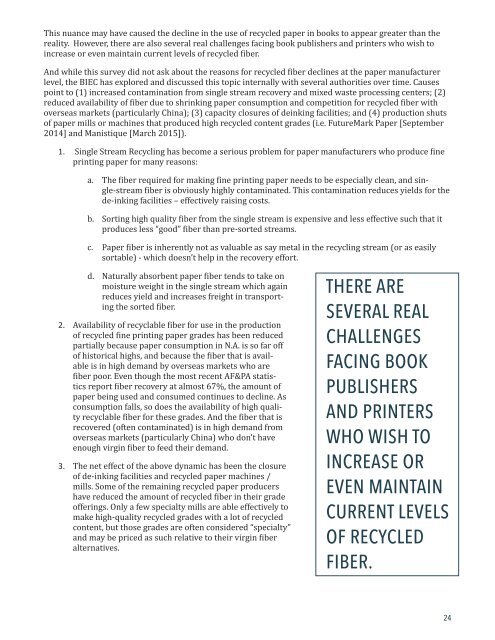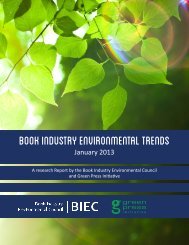BOOK INDUSTRY ENVIRONMENTAL TRENDS 2016
4TaCUk0vP
4TaCUk0vP
Create successful ePaper yourself
Turn your PDF publications into a flip-book with our unique Google optimized e-Paper software.
This nuance may have caused the decline in the use of recycled paper in books to appear greater than the<br />
reality. However, there are also several real challenges facing book publishers and printers who wish to<br />
increase or even maintain current levels of recycled fiber.<br />
And while this survey did not ask about the reasons for recycled fiber declines at the paper manufacturer<br />
level, the BIEC has explored and discussed this topic internally with several authorities over time. Causes<br />
point to (1) increased contamination from single stream recovery and mixed waste processing centers; (2)<br />
reduced availability of fiber due to shrinking paper consumption and competition for recycled fiber with<br />
overseas markets (particularly China); (3) capacity closures of deinking facilities; and (4) production shuts<br />
of paper mills or machines that produced high recycled content grades (i.e. FutureMark Paper [September<br />
2014] and Manistique [March 2015]).<br />
1. Single Stream Recycling has become a serious problem for paper manufacturers who produce fine<br />
printing paper for many reasons:<br />
a. The fiber required for making fine printing paper needs to be especially clean, and single-stream<br />
fiber is obviously highly contaminated. This contamination reduces yields for the<br />
de-inking facilities – effectively raising costs.<br />
b. Sorting high quality fiber from the single stream is expensive and less effective such that it<br />
produces less “good” fiber than pre-sorted streams.<br />
c. Paper fiber is inherently not as valuable as say metal in the recycling stream (or as easily<br />
sortable) - which doesn’t help in the recovery effort.<br />
d. Naturally absorbent paper fiber tends to take on<br />
moisture weight in the single stream which again<br />
reduces yield and increases freight in transporting<br />
the sorted fiber.<br />
2. Availability of recyclable fiber for use in the production<br />
of recycled fine printing paper grades has been reduced<br />
partially because paper consumption in N.A. is so far off<br />
of historical highs, and because the fiber that is available<br />
is in high demand by overseas markets who are<br />
fiber poor. Even though the most recent AF&PA statistics<br />
report fiber recovery at almost 67%, the amount of<br />
paper being used and consumed continues to decline. As<br />
consumption falls, so does the availability of high quality<br />
recyclable fiber for these grades. And the fiber that is<br />
recovered (often contaminated) is in high demand from<br />
overseas markets (particularly China) who don’t have<br />
enough virgin fiber to feed their demand.<br />
3. The net effect of the above dynamic has been the closure<br />
of de-inking facilities and recycled paper machines /<br />
mills. Some of the remaining recycled paper producers<br />
have reduced the amount of recycled fiber in their grade<br />
offerings. Only a few specialty mills are able effectively to<br />
make high-quality recycled grades with a lot of recycled<br />
content, but those grades are often considered “specialty”<br />
and may be priced as such relative to their virgin fiber<br />
alternatives.<br />
THERE ARE<br />
SEVERAL REAL<br />
CHALLENGES<br />
FACING <strong>BOOK</strong><br />
PUBLISHERS<br />
AND PRINTERS<br />
WHO WISH TO<br />
INCREASE OR<br />
EVEN MAINTAIN<br />
CURRENT LEVELS<br />
OF RECYCLED<br />
FIBER.<br />
24



